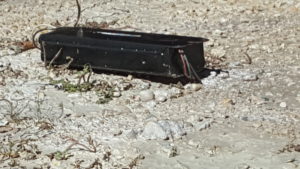On February 12, 2015 a person who I assume to be a demolition contractor – not a customer of mine – asked a question through the Contact Me page of my website.
 I am working on a demolition project removing a coal fed power plant. The demolition crew is in the process of removing universal waste and as they remove the light ballasts we are checking for PCB/No PCB’s to determine how to dispose of them. Now reading further into the disposal process I came across DEHP. I did a little research on this DEHP and on your website it says that DEHP is a hazardous waste if it’s pure, but once used in a ballast it will no longer meet the description of a U-listed hazardous waste. My interpretation of that is it is no longer a hazardous waste and can be disposed of as construction debris as long as is not exhibiting leakage. Please respond. Thank You.
I am working on a demolition project removing a coal fed power plant. The demolition crew is in the process of removing universal waste and as they remove the light ballasts we are checking for PCB/No PCB’s to determine how to dispose of them. Now reading further into the disposal process I came across DEHP. I did a little research on this DEHP and on your website it says that DEHP is a hazardous waste if it’s pure, but once used in a ballast it will no longer meet the description of a U-listed hazardous waste. My interpretation of that is it is no longer a hazardous waste and can be disposed of as construction debris as long as is not exhibiting leakage. Please respond. Thank You.
On February 17, 2015 I replied.
Thank you for contacting me with your question. I apologize for taking so long in getting back to you.
I assume you read my blog article on the disposal of lighting ballast. I’m glad you were able to use it as guidance. In sum:
- The generator of a waste is required to make the hazardous waste determination based on generator knowledge (e.g. “No PCB” written on a ballast and/or its date of manufacture) or analytical (e.g. collecting a sample and submitting it to a lab for analysis).
- Unless disposed of unused, DEHP is not a listed hazardous waste.
- A ballast may be a hazardous waste if it exhibits a characteristic (i.e. Ignitability, Corrosivity, Reactivity, Toxcity). While I don’t think a ballast will exhibit any of these hazardous waste characteristics, it is possible and it is the generator’s responsibility to make this determination.
- If the ballast does not contain PCBs, is used and therefore not a U-Listed hazardous waste, and does not exhibit a characteristic, then it is not a hazardous waste and can be disposed of in non-hazardous (Subtitle D) landfill. Whether it is leaking or not should not be an issue.
- Free liquids cannot go to landfill.
- The landfill may not wish to accept this waste – or any other – at its own discretion.
- I am not familiar with construction debris landfills to speak to that issue.
- Recycling as scrap metal (if approved by the recycler) is preferable to landfill disposal (in my opinion).
I hope this helps.
Dan
On February 18, 2015 questioner replied.
Thank You for your reply.
Got a question? Whether your a customer of mine or not I’m glad to help in any way I can.
Daniels Training Services 815.821.1550 |

